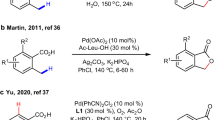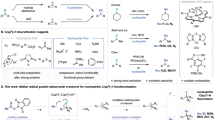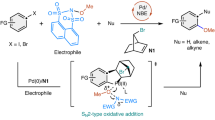Abstract
Methods for carbon–hydrogen (C–H) bond oxidation have a fundamental role in synthetic organic chemistry, providing functionality that is required in the final target molecule or facilitating subsequent chemical transformations. Several approaches to oxidizing aliphatic C–H bonds have been described, drastically simplifying the synthesis of complex molecules1,2,3,4,5,6. However, the selective oxidation of aromatic C–H bonds under mild conditions, especially in the context of substituted arenes with diverse functional groups, remains a challenge. The direct hydroxylation of arenes was initially achieved through the use of strong Brønsted or Lewis acids to mediate electrophilic aromatic substitution reactions with super-stoichiometric equivalents of oxidants, significantly limiting the scope of the reaction7. Because the products of these reactions are more reactive than the starting materials, over-oxidation is frequently a competitive process. Transition-metal-catalysed C–H oxidation of arenes with or without directing groups has been developed, improving on the acid-mediated process; however, precious metals are required8,9,10,11,12,13. Here we demonstrate that phthaloyl peroxide functions as a selective oxidant for the transformation of arenes to phenols under mild conditions. Although the reaction proceeds through a radical mechanism, aromatic C–H bonds are selectively oxidized in preference to activated  –H bonds. Notably, a wide array of functional groups are compatible with this reaction, and this method is therefore well suited for late-stage transformations of advanced synthetic intermediates. Quantum mechanical calculations indicate that this transformation proceeds through a novel addition–abstraction mechanism, a kind of ‘reverse-rebound’ mechanism as distinct from the common oxygen-rebound mechanism observed for metal–oxo oxidants. These calculations also identify the origins of the experimentally observed aryl selectivity.
–H bonds. Notably, a wide array of functional groups are compatible with this reaction, and this method is therefore well suited for late-stage transformations of advanced synthetic intermediates. Quantum mechanical calculations indicate that this transformation proceeds through a novel addition–abstraction mechanism, a kind of ‘reverse-rebound’ mechanism as distinct from the common oxygen-rebound mechanism observed for metal–oxo oxidants. These calculations also identify the origins of the experimentally observed aryl selectivity.
This is a preview of subscription content, access via your institution
Access options
Subscribe to this journal
Receive 51 print issues and online access
$199.00 per year
only $3.90 per issue
Buy this article
- Purchase on Springer Link
- Instant access to full article PDF
Prices may be subject to local taxes which are calculated during checkout






Similar content being viewed by others
Accession codes
Data deposits
Supplementary crystallographic data for compound 2a–int have been deposited at the Cambridge Crystallographic Data Centre under accession number CCDC903297. These data can be obtained free of charge at http://www.ccdc.cam.ac.uk/data_request/cif.
References
Chen, M. S. & White, C. M. A predictably selective aliphatic C–H oxidation reaction for complex molecule synthesis. Science 318, 783–787 (2007)
Chen, K. & Baran, P. S. Total synthesis of eudesmane terpenes by site-selective C–H oxidations. Nature 459, 824–828 (2009)
Chen, M. S. & White, C. M. Combined effects on selectivity in Fe-catalyzed methylene oxidation. Science 327, 566–571 (2010)
Gutekunst, W. R. & Baran, P. S. C–H functionalization logic in total synthesis. Chem. Soc. Rev. 40, 1976–1991 (2011)
Simmons, E. M. & Hartwig, J. F. Catalytic functionalization of unactivated primary C–H bonds directed by an alcohol. Nature 483, 70–73 (2012)
Roizen, J. L., Harvey, M. E. & Du Bois, J. Metal-catalyzed nitrogen-atom transfer methods for the oxidation of aliphatic C–H bonds. Acc. Chem. Res. 45, 911–922 (2012)
Rappoport, Z. The Chemistry of Phenols Vols 1 and 2, 395–490 (Wiley-VCH, 2003)
Neufeldt, S. R. & Sanford, M. S. Controlling site selectivity in palladium-catalyzed C–H bond functionalization. Acc. Chem. Res. 45, 936–946 (2012)
Emmert, M. H., Cook, A. K., Xie, Y. J. & Sanford, M. S. Remarkably high reactivity of Pd(OAc)2/pyridine catalysts: nondirected C–H oxygenation of arenes. Angew. Chem. Int. Ed. 50, 9409–9412 (2011)
Zhang, Y.-H. & Yu, J.-Q. Pd(II)-catalyzed hydroxylation of arenes with 1 atm of O2 or air. J. Am. Chem. Soc. 131, 14654–14655 (2009)
Huang, C., Ghavtadze, N., Chattopadhyay, B. & Gevorgyan, V. Synthesis of catechols from phenols via Pd-catalyzed silanol-directed C–H oxygenation. J. Am. Chem. Soc. 133, 17630–17633 (2011)
Gulevich, A. V., Melkonyan, F. S., Sarkar, D. & Gevorgyan, V. Double-fold C–H oxygenation of arenes using PyrDipSi: a general and efficient traceless/modifiable silicon-tethered directing group. J. Am. Chem. Soc. 134, 5528–5531 (2012)
Powers, D. C., Xiao, D. Y., Geibel, M. A. L. & Ritter, T. On the mechanism of palladium-catalyzed aromatic C–H oxidation. J. Am. Chem. Soc. 132, 14530–14536 (2010)
Russell, K. E. The preparation of phthalyl peroxide and its decomposition in solution. J. Am. Chem. Soc. 77, 4814–4815 (1955)
Greene, F. D. Cyclic diacyl peroxides. II. Reaction of phthaloyl peroxide with cis- and trans-stilbene. J. Am. Chem. Soc. 78, 2250–2254 (1956)
Greene, F. D. & Rees, W. W. Cyclic diacyl peroxides. III. The reaction of phthaloyl peroxide with olefins. J. Am. Chem. Soc. 80, 3432–3437 (1958)
Yuan, C., Axelrod, A., Varela, M., Danysh, L. & Siegel, D. Synthesis and reaction of phthaloyl peroxide derivatives, potential organocatalysts for the stereospecific dihydroxylation of alkenes. Tetrahedr. Lett. 52, 2540–2542 (2011)
Fujimori, K., Oshibe, Y., Hirose, Y. & Oae, S. Thermal decomposition of diacyl peroxide. Part 11. 18O-scrambling in carbonyl-18O-labelled phthaloyl peroxide, a cyclic case III diacyl peroxide. Extremely large return of unescapable acyloxyl radical pair. J. Chem. Soc. Perkin Trans. 2 413–417 (1996)
Ensing, B., Buda, F., Gribnau, M. C. M. & Baerends, E. J. Methane-to-methanol oxidation by the hydrated iron(IV) oxo species in aqueous solution: a combined DFT and Car-Parrinello molecular dynamics study. J. Am. Chem. Soc. 126, 4355–4365 (2004)
Curci, R., D’Accolti, L. & Fusco, C. A novel approach to the efficient oxygenation of hydrocarbons under mild conditions. Superior oxo transfer selectivity using dioxiranes. Acc. Chem. Res. 39, 1–9 (2006)
Shuklov, I. A., Dubrovina, N. V. & Börner, A. Fluorinated alcohols as solvents, cosolvents and additives in homogeneous catalysis. Synthesis 2925–2943. (2007)
Virtamo, J. et al. Incidence of cancer and mortality following alpha-tocipherol and beta-carotene supplementation: a postintervention follow-up. J. Am. Med. Assoc. 3, 962–986 (2011)
Wilkerson, W. W., Galbraith, W., DeLucca, I. & Harris, R. R. Topical antiinflammatory dehydroabietylamine derivatives IV. Bioorg. Med. Chem. Lett. 3, 2087–2092 (1993)
Malkowsky, I. M., Nieger, M., Kataeva, O. & Waldvogel, S. R. Synthesis and properties of optically pure phenols derived from (+)-dehydroabietylamine. Synthesis 773–778 (2007)
Wender, P. A., Verma, V. A., Paxton, T. J. & Pillow, T. H. Function-oriented synthesis, step economy, and drug design. Acc. Chem. Res. 41, 40–49 (2008)
Cheng, X., Harzdorf, N. L., Shaw, T. & Siegel, D. Biomimetic syntheses of the neurotrophic natural products caryolanemagnolol and clovanemagnolol. Org. Lett. 12, 1304–1307 (2010)
Frisch, M. J. et al. GAUSSIAN09, Revision C.01 (Gaussian, Inc., 2010)
Jursic, B. S. & Martin, R. M. Calculation of bond dissociation energies for oxygen containing molecules by ab initio and density functional theory methods. Int. J. Quantum Chem. 59, 495–501 (1996)
Wang, J., Tsuchiya, M., Tokumaru, K. & Sakuragi, H. Intramolecular hydrogen-atom transfer in 2-alkylbenzoyloxyl radicals as studied by transient absorption kinetics and product analyses on the photodecomposition of bis(2-alkylbenzoyl) peroxides. Bull. Chem. Soc. Jpn. 68, 1213–1219 (1995)
Takahara, S. et al. The role of aroyloxyl radicals in the formation of solvent-derived products in photodecomposition of diaroyl peroxides. The reactivity of substituted cyclohexadienyl radicals and intermediacy of ipso intermediates. Bull. Chem. Soc. Jpn. 58, 688–697 (1985)
Acknowledgements
Financial support from the University of Texas at Austin, the Welch Foundation (F-1694 to D.S.), and the US National Science Foundation (CHE-1059084 to K.N.H.) are gratefully acknowledged. Calculations were performed on the Extreme Science and Engineering Discovery Environment (XSEDE), which is supported by the US National Science Foundation (OCI-1053575).
Author information
Authors and Affiliations
Contributions
C.Y. designed experiments; C.Y., T.H. and A.B. carried out experiments; Y.L. and K.N.H. carried out computational analyses; C.Y., Y.L., K.N.H. and D.S. analysed data; K.N.H. and D.S. supervised research; C.Y., Y.L., K.N.H. and D.S. wrote the paper.
Corresponding author
Ethics declarations
Competing interests
The authors declare no competing financial interests.
Supplementary information
Supplementary Information
This file contains Supplementary Text and Data sections 1-10 – see contents page for details. The Supplementary Information was amended to include a new safety protocol on 24 September 2013 (PDF 13448 kb)
Rights and permissions
About this article
Cite this article
Yuan, C., Liang, Y., Hernandez, T. et al. Metal-free oxidation of aromatic carbon–hydrogen bonds through a reverse-rebound mechanism. Nature 499, 192–196 (2013). https://doi.org/10.1038/nature12284
Received:
Accepted:
Published:
Issue Date:
DOI: https://doi.org/10.1038/nature12284
This article is cited by
-
Strategic application of C–H oxidation in natural product total synthesis
Nature Reviews Chemistry (2023)
-
Deoxyfluorination of phenols for chemoselective 18F-labeling of peptides
Nature Protocols (2023)
-
Electrochemical aromatic C–H hydroxylation in continuous flow
Nature Communications (2022)
-
The interplay of polar effects in controlling the selectivity of radical reactions
Nature Synthesis (2022)
-
Selective Aerobic Oxidation of Secondary C (sp3)-H Bonds with NHPI/CAN Catalytic System
Catalysis Letters (2021)
Comments
By submitting a comment you agree to abide by our Terms and Community Guidelines. If you find something abusive or that does not comply with our terms or guidelines please flag it as inappropriate.



